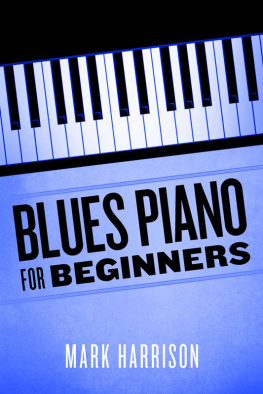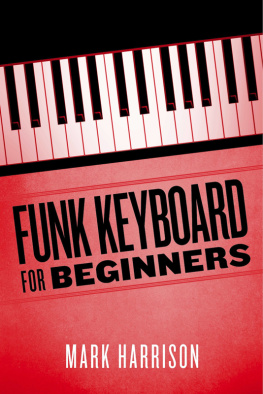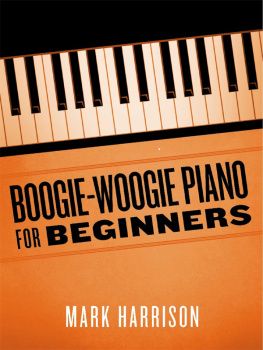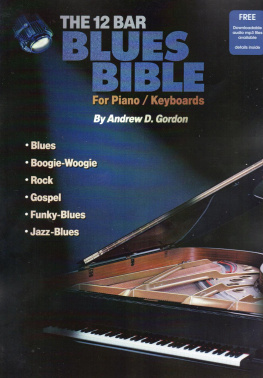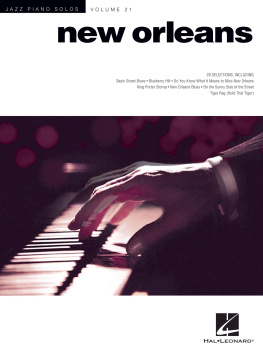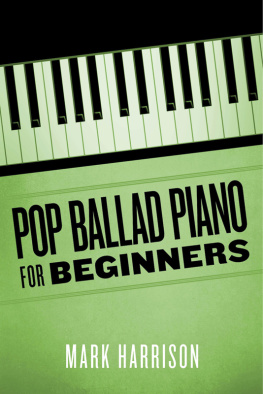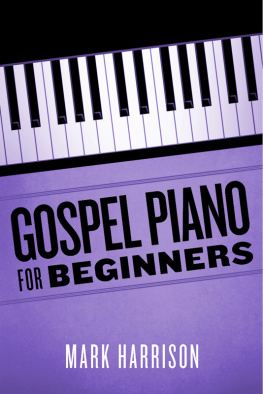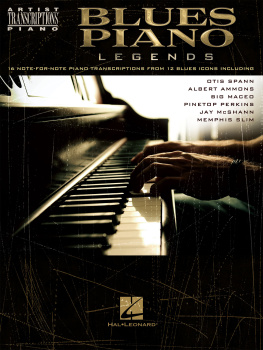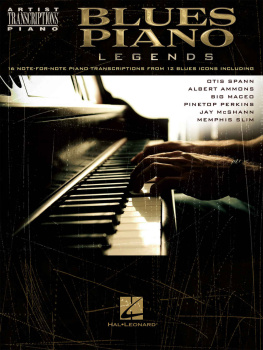Mark Harrison - Blues Piano For Beginners
Here you can read online Mark Harrison - Blues Piano For Beginners full text of the book (entire story) in english for free. Download pdf and epub, get meaning, cover and reviews about this ebook. year: 2013, publisher: BookBaby, genre: Children. Description of the work, (preface) as well as reviews are available. Best literature library LitArk.com created for fans of good reading and offers a wide selection of genres:
Romance novel
Science fiction
Adventure
Detective
Science
History
Home and family
Prose
Art
Politics
Computer
Non-fiction
Religion
Business
Children
Humor
Choose a favorite category and find really read worthwhile books. Enjoy immersion in the world of imagination, feel the emotions of the characters or learn something new for yourself, make an fascinating discovery.
- Book:Blues Piano For Beginners
- Author:
- Publisher:BookBaby
- Genre:
- Year:2013
- Rating:3 / 5
- Favourites:Add to favourites
- Your mark:
- 60
- 1
- 2
- 3
- 4
- 5
Blues Piano For Beginners: summary, description and annotation
We offer to read an annotation, description, summary or preface (depends on what the author of the book "Blues Piano For Beginners" wrote himself). If you haven't found the necessary information about the book — write in the comments, we will try to find it.
Blues Piano For Beginners — read online for free the complete book (whole text) full work
Below is the text of the book, divided by pages. System saving the place of the last page read, allows you to conveniently read the book "Blues Piano For Beginners" online for free, without having to search again every time where you left off. Put a bookmark, and you can go to the page where you finished reading at any time.
Font size:
Interval:
Bookmark:


Published by: Harrison Music Education Systems, P.O. Box 5068, West Hills, CA 91308, USA
Publication date: 01/01/12
Copyright: 2012 Mark Harrison
ISBN Number: 9781618427199
For information on our music education books and CDs, downloadable products and packages, and private on-line lessons, please visit our website: www.harrisonmusic.com
Welcome to Blues Piano For Beginners. This book will start you on the road to playing authentic blues piano, even if you are a complete beginner. Youll get started right away by learning some essential left-hand and right-hand patterns to use on your first (or next) blues piano gig!
Please email us at with Beginning Blues Audio in the subject, to receive your FREE mp3 audio recordings of all the music examples in this book! Most of the audio recordings feature a rhythm section on the left channel, and the piano on the right channel. To play along with the band, turn down the right channel to eliminate the recorded piano. To hear the piano part for reference, turn down the left channel to eliminate the rhythm section.
Some eReaders will display the music notation in this book more clearly than others, so along with your free mp3s you will also receive pdf versions of all the music notation examples, as a backup for your use if needed.
The foundation of a great blues piano performance is the strong and steady left hand pattern. Our first blues piano left hand pattern uses fifth and sixth intervals and a swing eighths rhythmic feel, as follows:
Example 1

Here in the bass clef, C and G are played together during beats 1 and 3 of each measure, and C and A are played together during beats 2 and 4 of each measure. Be sure to check out the mp3 audio track for this example (especially if your note reading is at a beginning level!) Also the fingering numbers are shown on the staff: the pinky is playing the C, and the index finger and thumb are playing the G and A respectively. The fingering simile note in the second measure, means that the fingering is the same as for the first measure.
The eighth-note rhythmic counting (1 & 2 & 3 & 4 &) is shown above the staff. This is how eighth notes are counted, with the 1, 2, 3 and 4 falling on the downbeats, and the &s in between falling on the upbeats. In this swing eighths example, all of the &s actually land two-thirds of the way through each beat, giving the rhythm a more loping or shuffle type of feel. Count along to the mp3 audio track accompanying this example, to get comfortable with this rhythmic idea. All of the music examples in this book have a swing eighths feel, which is very common and traditional in piano blues.
This left hand pattern will work on a C major or C dominant 7th chord in a blues song (moving between the root-5th and root-6th of the chord).
In the next example weve added a simple C major triad (three-note chord) in the right hand, over the previous pattern in the left hand:
Example 2

Note that the left hand pattern and fingering are the same as for Example 1. Above this in the right hand, we have the C major triad played as whole notes (which last for four beats each). The right hand fingering is also shown, with the thumb, middle finger and pinky playing the notes C, E and G respectively.
As you play this example, focus on getting the left hand pattern steady and consistent, with the right hand triads landing on beat 1 of each measure. You can count through it in a similar way to Example 1 (1 & 2 & 3 & 4 &) if needed. Again if you are unsure about how this example sounds, check out the accompanying mp3 audio track. Then when youre ready, play along to the rhythm section track on the left channel!
Theory note: The C major triad is built by taking the first, third, and fifth degrees of a C major scale. The third of the chord (E) is a major third interval above the root, and the fifth of the chord (G) is a perfect fifth interval above the root. The chord symbol above the staff (C) denotes a C major triad.
Next we need to develop this blues comping or accompaniment idea, over a blues chord progression. A simple blues progression can be created using I, IV and V chords within a key (this is equivalent to building chords from the first, fourth and fifth degrees of a major scale). First well need to review a little bit of theory to see where these chords come from:
Example 3

In this example, the empty noteheads spell out a C major scale (C-D-E-F-G-A-B-C from left to right). Above the first, fourth and fifth degrees (C, F and G) we have built C major, F major and G major triads respectively.
Theory note: The C major scale (like all major scales) is spelled using whole-step, whole-step, half-step, whole-step, whole-step, whole-step, and half-step intervals in an ascending sequence. These C, F and G major triads are all diatonic to the key of C, meaning they are all contained within the C major scale.
In the next example well see how these C, F and G major triads can be used on a twelve-bar blues progression in the key of C:
Example 4



This progression contains twelve bars or measures, and is the standard form used for a great many blues songs! This basic twelve-bar form consists of three four-measure sections, which start with the I chord (C), the IV chord (F), and the V chord (G) respectively.
Note the piano pattern used is the same as for Example 2, with the right hand playing whole-note triads, and the left hand playing root-fifth and root-sixth intervals on all of the eighth note subdivisions. Make sure that you look ahead for the hand position changes needed (for example, the left hand pinky jumping down to F in measure 2) - this will help you play the pattern in tempo, rather than pausing at the point of chord change to figure out where to go!
Again when youre ready, play along with the rhythm section on the left channel of the audio track, to get comfortable with this classic blues progression.
So far, all of our right hand triads have been in root position, meaning that the root is on the bottom of each triad (i.e. C is the bottom note of the C major triad, F is the bottom note of the F major triad, and so on). Next well start using some triad inversions, where the root is no longer the bottom note in the right hand. This will give us lots of useful ways to move from one chord to another!
First of all well use triad inversions to give us some movement and variation within the C major chord we started out with:
Example 5
Next pageFont size:
Interval:
Bookmark:
Similar books «Blues Piano For Beginners»
Look at similar books to Blues Piano For Beginners. We have selected literature similar in name and meaning in the hope of providing readers with more options to find new, interesting, not yet read works.
Discussion, reviews of the book Blues Piano For Beginners and just readers' own opinions. Leave your comments, write what you think about the work, its meaning or the main characters. Specify what exactly you liked and what you didn't like, and why you think so.

